A limited marketing budget is something SMBs have to struggle with. They need to use profitable and effective strategies. SEO is a long-term marketing strategy that they could be investing in.
Luckily, there are effective strategies that will improve your business’s search visibility. Let’s get started with these SEO strategies for small businesses.
[joli-toc]
1. Focus on Long-Tail Keywords
Long-tail keywords have low search volume but with focused search intent. You may be asking yourself, “but Carlos, if they are not popular keywords, why should I focus on them?”
This is a question I’ve been asked very often, and the answer is that most Google searches are long-tail keywords. Very popular keywords tend to be very specific keywords with unclear search intent.
For example, the keyword “hamburger”. What is the search intent? Maybe the users want to search for restaurants, a recipe, a list of different types of hamburgers, etc.
This is not an issue with these long-tail keywords: “hamburgers in west Ottawa”, or “how do you make hamburgers juicy”. They both have two different search intents, and it is impossible to know with the generic search “hamburger”.
Let’s add some data to this answer. An Ahrefs analysis showed that 92.43% of them get 10 searches per month or less!
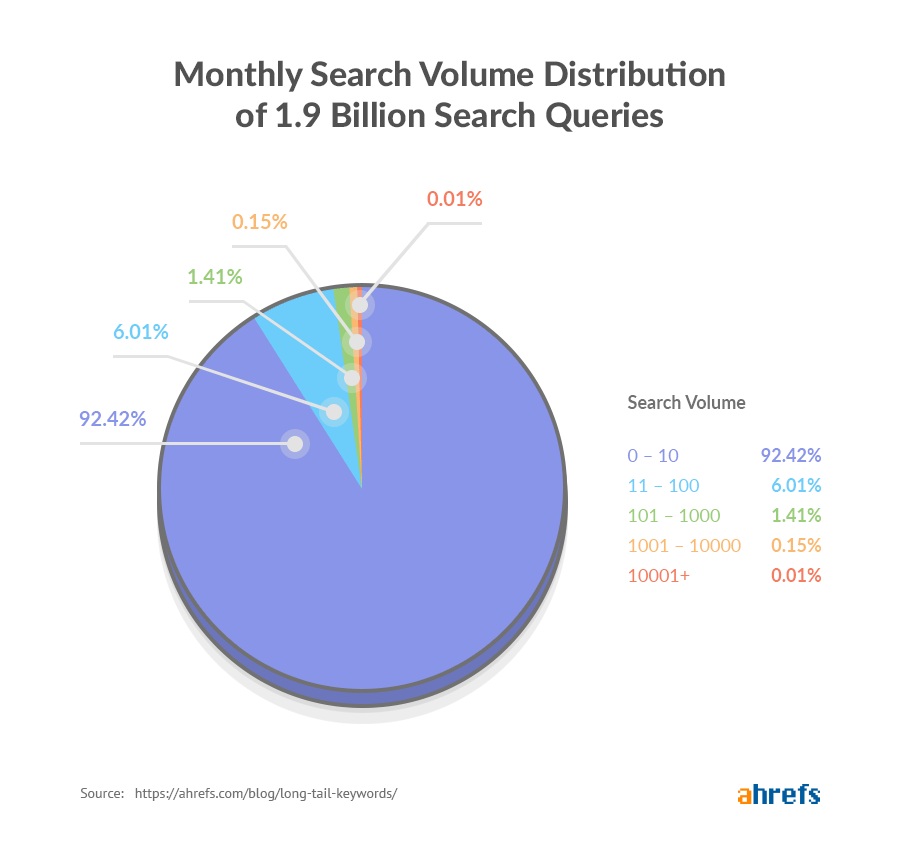
Monthly Search Volume Distribution of 1.9 Billion Search Queries
As a small business, you need to find ways to connect with your customers. Long-tail queries are great for identifying what your audience is specifically searching for.
With great content and very little link building, you can rank #1 for these keywords that will drive you qualified leads and customers.
2. Understand the Importance of Technical SEO
Your website’s technical structure can have a huge impact on its performance. As a small business, you have a great advantage compared to other big brands in your industry: you can implement and fix things much more quickly.
Whenever there is a technical SEO problem like broken URLs, chains of redirects, broken internal links, etc., big brands cannot fix the issue immediately.
They need to contact the development team, informing them of the detected issue, and the lead developer adds it to his team’s to-do list. If they don’t have a monitoring tool for this kind of issue, they won’t notice immediately and will likely discover it during a scheduled crawl.
Small businesses can identify these issues with a quick Screaming Frog crawling and know exactly which URLs are having problems. They can then fix the issue themselves or contact the person in charge of the website, asking them to fix the issue.
You must monitor changes to your robots.txt and sitemap that could cause crawlability and indexability issues and check for broken internal and external links, URLs with redirect chains, website speed issues, etc.
3. Enhance Your Local SEO with Google My Business
If you are a restaurant, a dental clinic or a gym, you may want to create a new or claim an existing Google My Business listing to enhance your Local SEO presence.
By creating an optimized Google My Business listing, your business has the chance to appear on the Google Local Search results that are shown in queries with local intent, as you can see in the screenshot below:
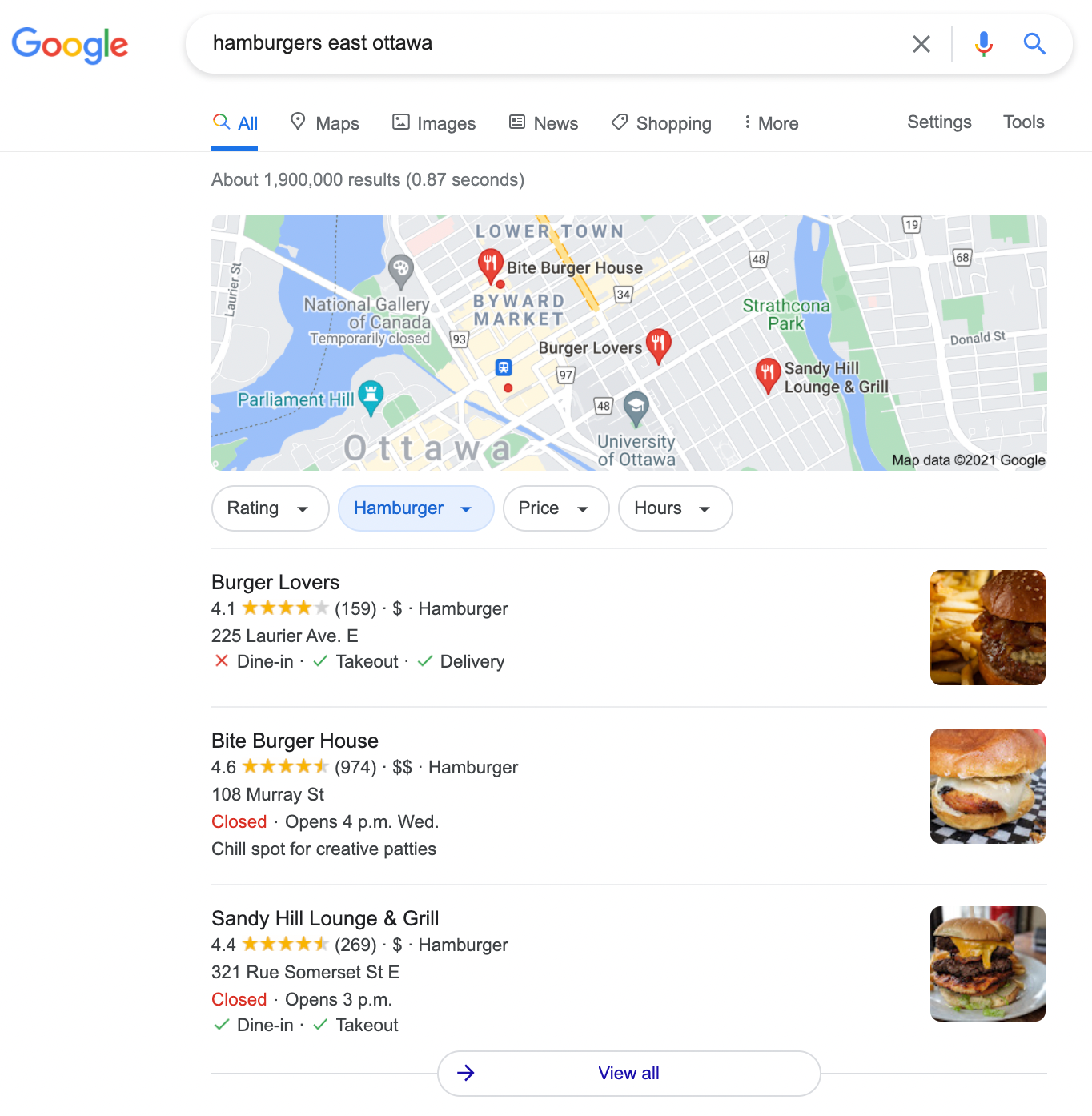
Google Local Search Results
4. Create a logical web structure
Both search engines and users appreciate a website that has a clear web structure. Users can find the information they need more easily. For example, in a small e-commerce site that sells smartphones, you may want to search first by brand and not by model.
Imagine you are searching for your new smartphone, but you want to change from an Android-based device to an iOS-based device, so you start by entering the Apple category and then choosing the models that best suit your needs. This is better than first entering the iPhone X category page and not comparing prices with models like iPhone 11 or iPhone 8.
As you can see, it is easier to understand when the web structure is “store/apple/iphone-x/” than “store/iphone-x/apple/”. Your web structure should be based on a logical content organization.
Make sure to organize your web structure correctly and avoid having pages within sections that are not relevant. Take a look at this crawl map generated with Sitebulb as an example of a well-organized web structure.

Crawl Map by Sitebulb
5. Have a Mobile-Friendly Website
Since Google started migrating websites to their Mobile-First Indexing, companies have invested in having a responsive website to be prepared for this new crawling and indexing approach.
With Mobile-First Indexing, Google predominantly uses your website’s mobile version for indexing and ranking. If you created your website after July 1, 2019, mobile-first indexing is already enabled for it.
Google has slowly started to migrate older websites to mobile-first indexing, giving those businesses time to deal with potential issues resulting in loss of organic rankings.
You can use Google’s Mobile-Friendly Test to validate if your website is mobile-friendly.
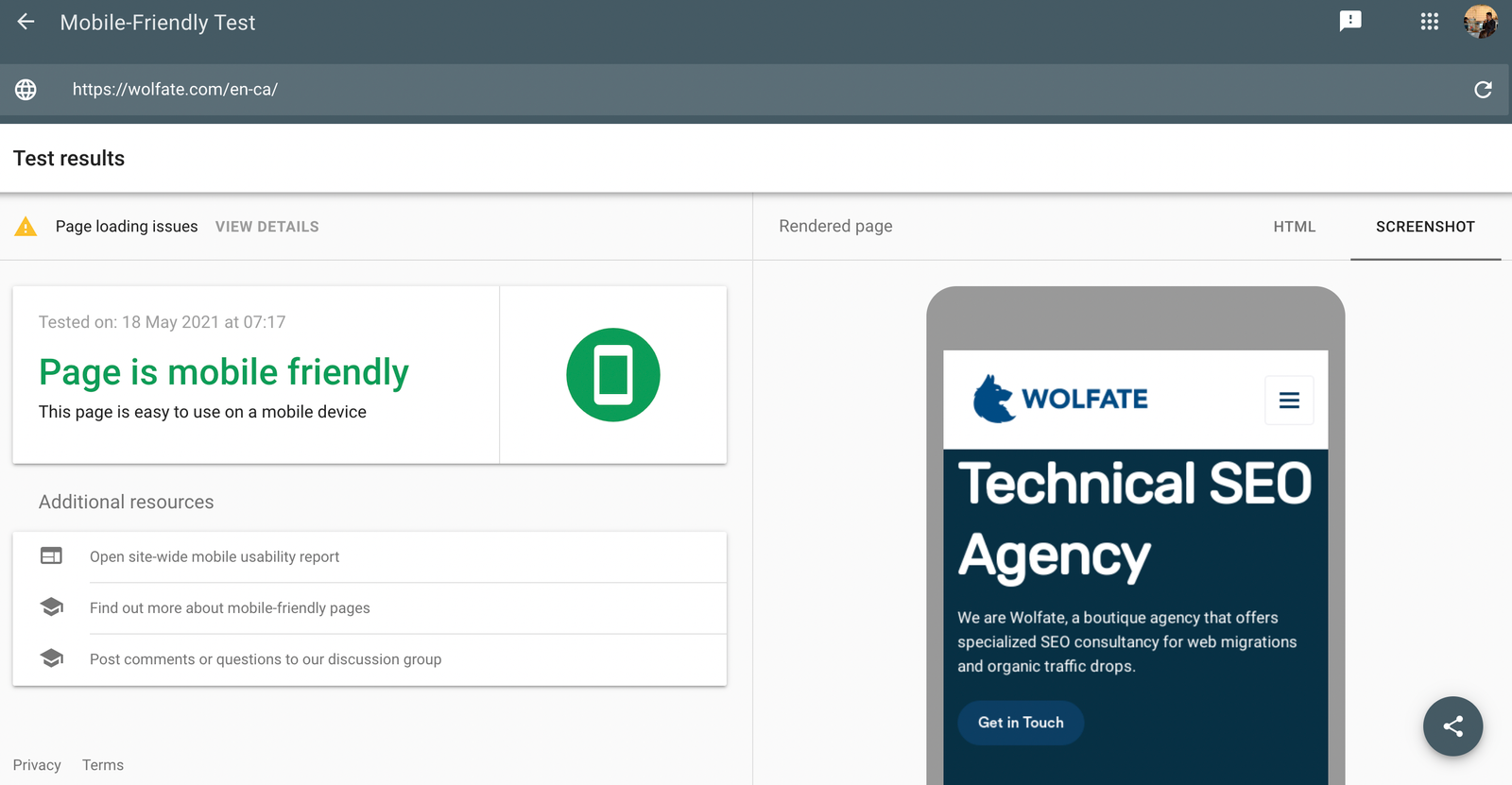
Mobile-Friendly Test
6. Focus on Creating TOFU Content
One of the main problems small businesses face is getting new clients. It is crucial to understand the AIDA model, which has 4 steps: Awareness, Interest, Desire, and Action.
You need to understand your potential clients’ problems regarding your product to create content that will answer those questions.
For example, let’s say you are a business that sells computers. When someone wants to buy a computer, they need to do some previous research like the best computer for students, designers, video editing, etc.
By knowing this, you now have to create guides that will help your user to find a solution to this first question. This content will need to be reachable to them either on the search results or social media.
This first step will let your potential client know that you understand them and answer the questions they have regarding your product.
After the user answers its question, they’ll want to know more about your products and what you have to offer. The best way to do this is by letting them know what you do and what makes your business different than others; you must have a unique selling proposition that will the user a reason to choose you and not your competitors.
Once they know what makes you stand out from other businesses, it is time to generate desire. They already enjoyed your content and think your product or service is the best. Offer them the possibility to subscribe to your newsletter in exchange for a coupon code or any other offer.
The last step is to give your potential clients the option to act on their desire. You know they want to buy something from you, so you need to include calls-to-action on your website and newsletter to incentivize their purchase.
If you have already shown empathy with your potential clients, convinced them that you stand out from the rest, and offered them a limited discount or offer, they will end buying from you.
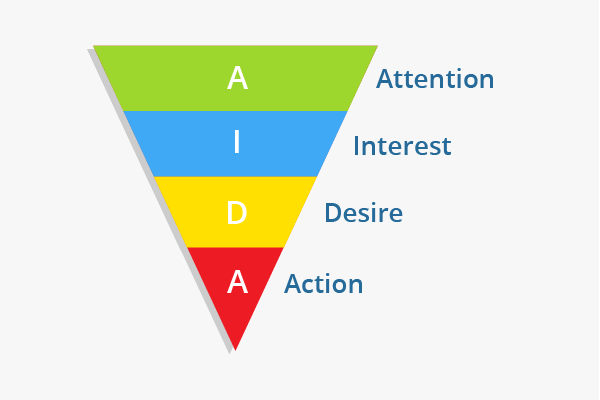
AIDA Model
7. Structure Your Content Correctly
I will use the last example of the computer business to explain this strategy. Use the inverted pyramid style of content writing. This method allows you to structure your content to allow the reader to gather information more easily.
Most blogs tend to introduce their main point after some extensive background intro. As a reader, I want to see the main point of the article right when I see the content.
You can think of it as a small AIDA version for content. In a concise paragraph, introduce the problem you are addressing and present a solution.
This is similar to what I have done in this article; I presented the problem many small businesses face and presented my solution for them. After that, I go into detail about my proposed solution.
At the end of the content, introduce a CTA. It can be as simple as a question to incentivize comments or a sign-up form to a newsletter.
8. Use Structured Data for Increased Visibility
Structured Data is a way of making it easier for Google to understand your content. When a website has recipes, job postings, or event information, it needs to be marked up, so search engines know that you have a specific type of content.
There are many things you can use structured data for; schema.org has a listing of all the things you can use structured data.
The best way to use structured data is with JSON-LD that can be inserted as a script in any HTML page. I use the Schema Markup Generator by Merkle Inc., which generates the JSON-LD code for your specified type of structured data, and you can test the code with either Google’s Structured Data Testing Tool or their new Rich Results Testing Tool.
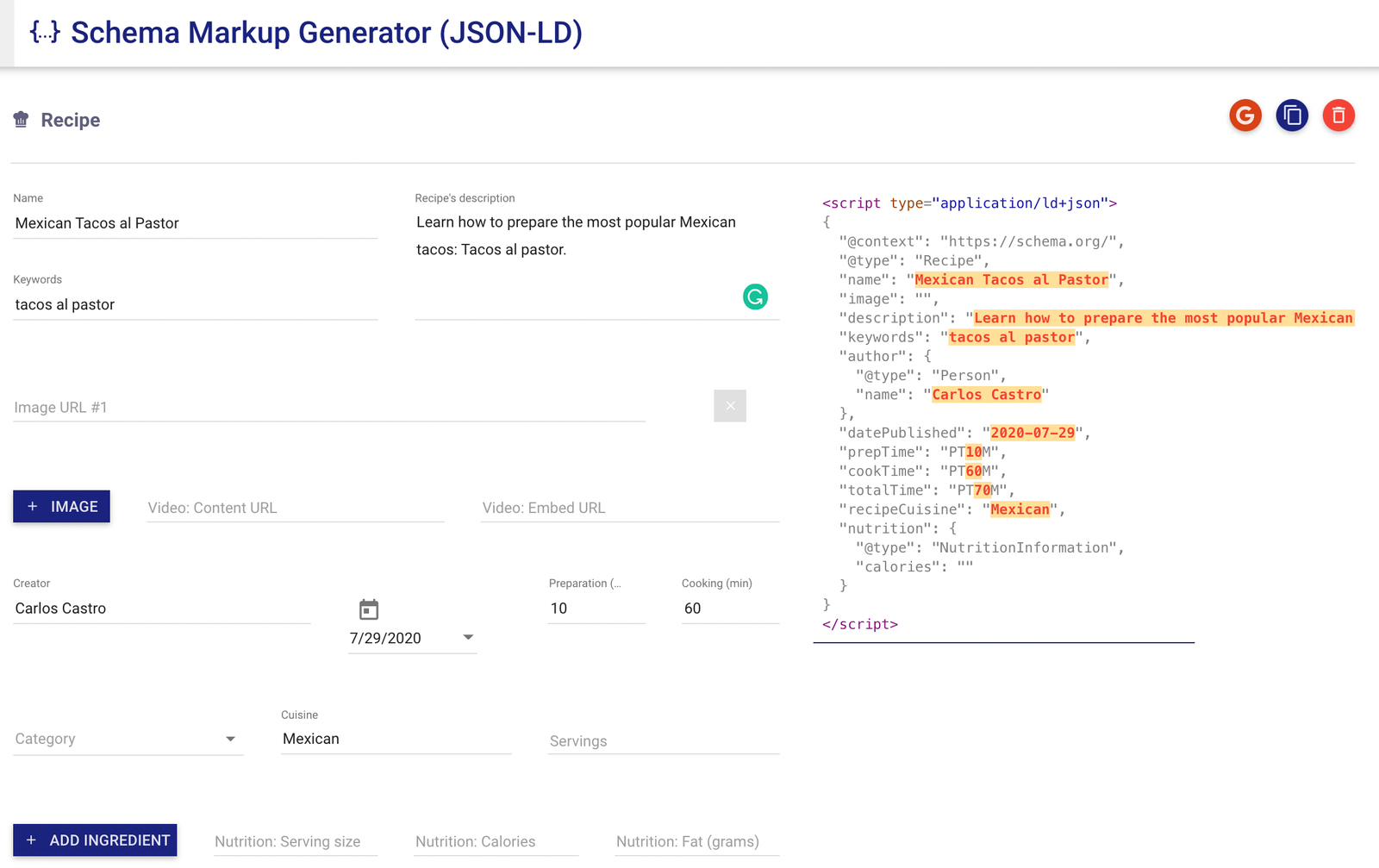
Schema Markup Generator
After you have implemented this JSON-LD code on your website, Google will be able to recognize your recipe’s structured data and may show your recipe on the search results like this:

Recipe Page on the SERPs
9. Optimize your Title and Description Tags for CTR
The click-through rate (CTR) is the ratio of users who click on a specific link to the number of total users who saw it. In terms of SEO, this represents the ratio of clicks in the organic search results vs the number of impressions the page has.
Backlinko’s CTR study shows that:
- The #1 result in Google’s organic search results has an average CTR of 31,7%
- Title tags between 15 to 40 characters have the highest CTR.
- Pages with a meta description get 5.8% more clicks than those without a description.
Backlinko found that the CTR of the top 3 organic results is 75.1%. But how do users choose which result to click on?
It all depends on how engaging their title tags and meta descriptions are; your title tag has to match the user’s intent of the search.
If a user is searching for “best laptops for students,” and the two top results have these title tags: “Best Laptops for Students 2020”, and “Best Laptops 2020”. It is clear that the first title tag clearly shows what the user is searching for.
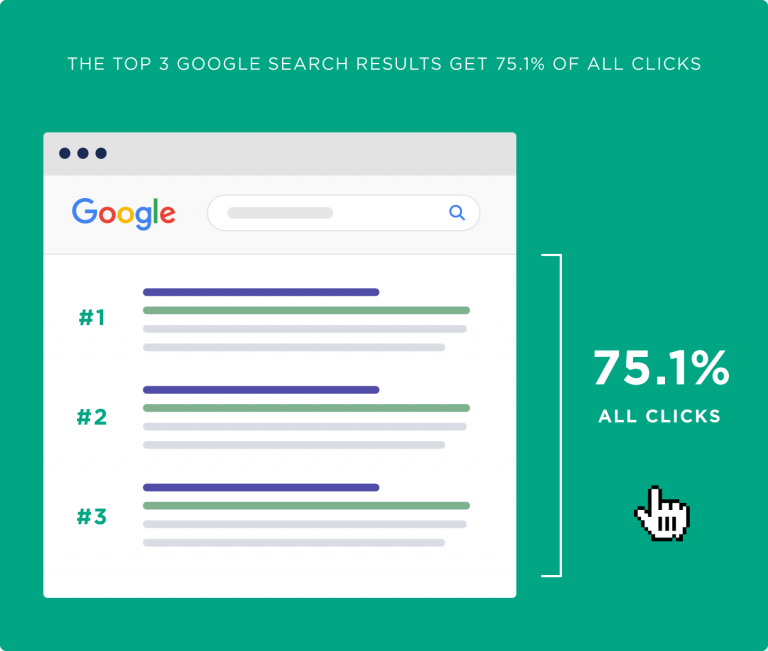
10. Start Building Your Online Authority
It can be difficult to build authority for your business if you’re just starting, but building online authority is somewhat easier.
You can build your business’s online authority by earning links to your website. Consider your links as “votes” or “references” other websites give you.
Earning links, however, can be challenging for small businesses with limited resources. Guest blogging and broken link building are the two main strategies that you can use to earn links.
Let’s say you are a business with a new healthy candy bar; you can reach out to food blogs that accept guest posts and write informational content about your product, for example, “More Sugar Doesn’t Always Mean More Flavour in a Candy Bar”.
You should write informational content, explain how sugar is unhealthy, how a candy bar can still be delicious with low sugar amounts, how you can eat your candy bar without any health concerns, etc.
Most sites allow you to link back to your website and include an author biography. You can write in your bio “Founder of Company X. The delicious candy bar with no sugar”.
You can also complement this guest blogging strategy with the broken link-building strategy. Let’s remember the example of the business that sells computers and published a guide on the best laptops for students.
You can see your competitors’ broken backlinks using the Free Broken Link Checker by Ahrefs and find out which sites link to pages for which you also have an alternative content page on your website.
Reach out to the author of that content and tell them about the broken link on their webpage and offer yours as a substitute for it, and just like that, you obtained a backlink that will add up to your website’s online authority.
If you can’t find any broken backlinks related to your published content, try and create pages with content similar to those broken pages of your competitors, improve their content and repeat the process of reaching out to the author.
Conclusion
You are now ready to improve your organic rankings with these SEO strategies for small businesses. Remember that implementing an SEO strategy takes time, so don’t expect immediate results like in PPC, but these strategies will allow your business’s organic visibility and rankings to improve over time.



